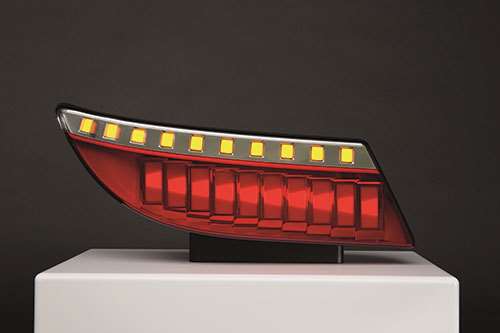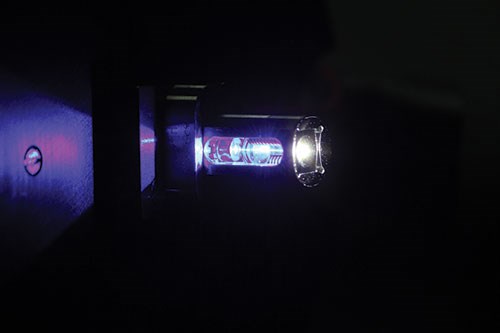OSRAM Shines A Little Light on the Future of Automotive Lighting
The light-maker is developing ultra-thin organic LEDs and laser headlights.
“Lights are the new chrome,” says David Hulick, marketing director for specialty solid-state lighting for OSRAM (osram.com), the German-based supplier of lamp systems for cars and trucks. Hulick is referring to the fact that headlamps and tail lamps—especially since the advent of LEDs—have become significant design cues for vehicles. That said, these are no mere decorations, as they must meet illumination regulations.
OSRAM engineers are busy developing technologies beyond conventional LEDs, namely super thin organic light-emitting diodes (OLEDs) and laser lights.
OLEDs are like an exceedingly thin sandwich, with an organic compound layered between an anode and a cathode. It produces light when a voltage is run between the outer layers and electrons generate radiation in the visible spectrum. The technology is already in use in some electronics, such as TV and cell phone screens, but one inhibitor to automotive use has been the ability to withstand the high temperatures that cars are subjected to (e.g., up to 85°C), a problem that OSRAM engineers have solved.
“We have essentially achieved road suitability for our OLEDs this year and will be offering initial special equipment based on OLEDs next year,” says Ulrich Eisele, head of the OLED sector. “In 2016 at the latest, we expect to see OLEDs used in series production of new vehicles.”
This year, OSRAM unveiled a tail lamp demonstrator, which uses a 1.4-mm white OLED (made from carbon and hydrogen). The OLED—think of it as a sheet of film—can be segmented into independent areas, so a separate brake light, turn signal and tail light can be produced from a single surface. The segmentation allows for individual patterns to be programmed into the tail light, including what the company calls a “welcome scenario.” The “scenario” is a light pattern—OSRAM engineers demonstrate a flashing pattern and a separate sequential illuminating pattern—that could be used by a vehicle owner to differentiate and more easily identify his/her ride.
“The thinness of the OLED provides space savings that open up greater design flexibility and styling differentiation in the lights,” explains Stefan Seidel, OSRAM’s marketing manager for OLED lighting.
The transparent, ultra-flat OLED produces no glare, consumes little power and produces high quality light for approximately 8,000 hours, comparable to existing LEDs in lifespan. Seidel says the flexibility of the technology could change tail lamp constructions, allowing designers more freedom to alter the shape of the rear lights.
Beyond 2016, LED and OLED techno-logy will begin to proliferate, OSRAM officials say. Yet developmental engineers at the company’s laboratories in Herbrechtingen, Germany, aren’t focused solely on LED and OLED solutions. These engineers are working on laser technology to light the way ahead in future vehicles. This technology is called “Laser Activated Remote Phosphor” (LARP). LARP produces white light when a blue laser hits a small reflector about the size of two American quarters, side-by-side.
“With the white light generated by the laser, we can achieve luminance substantially higher than [existing] LEDs,” explains Claus Allgeier, vice president for automotive solid-state lighting. Which means that it has promising headlight applications. The luminance is “unbeatable,” Allgeier says. Plus, the focal length of the LARP allows extremely small apertures, which means a lot of light could shine from a vehicle without taking up much space, or adding much weight.
“With LARP, new functionalities are expected in the future,” Allgeier adds. One new function is the ability to “steer” light with precision around bends, says Stefan Herold, an OSRAM engineer who heads the LARP project.
Fundamental challenges to laser lights remain, however. Thermal management, for example. A cooling system needs to be developed to endure the rigors of automotive use. And because mechanical tolerances get smaller with laser technology, requiring more precision in production. Additionally, safety regulations remain an obstacle, Herold adds.
“We can now create completely new solutions to automotive lighting and really enhance the performance of the lighting on the road,” Allgeier says.



